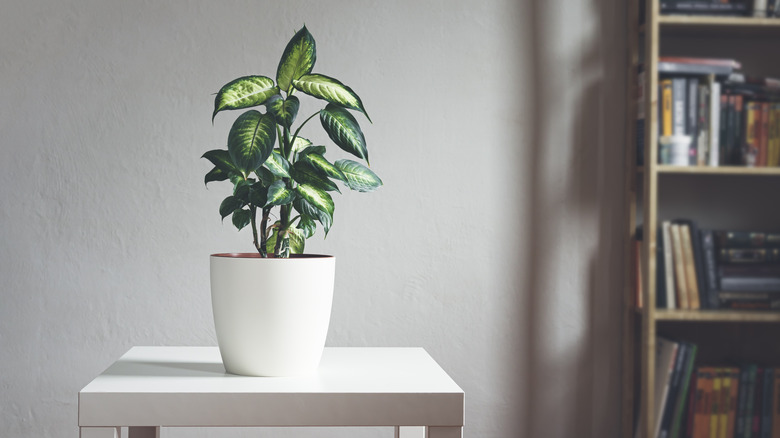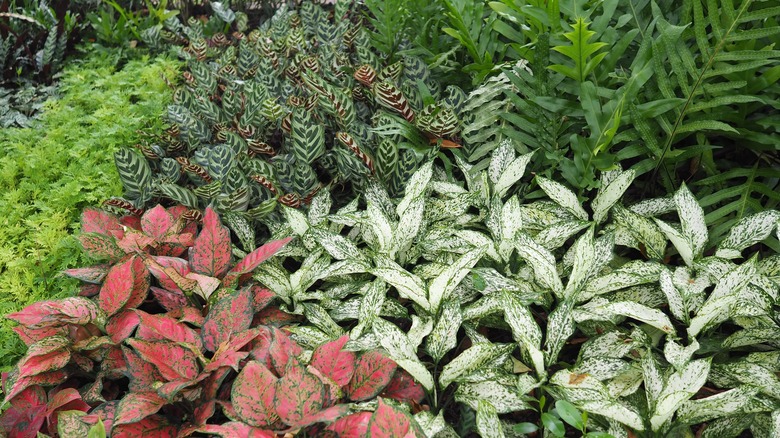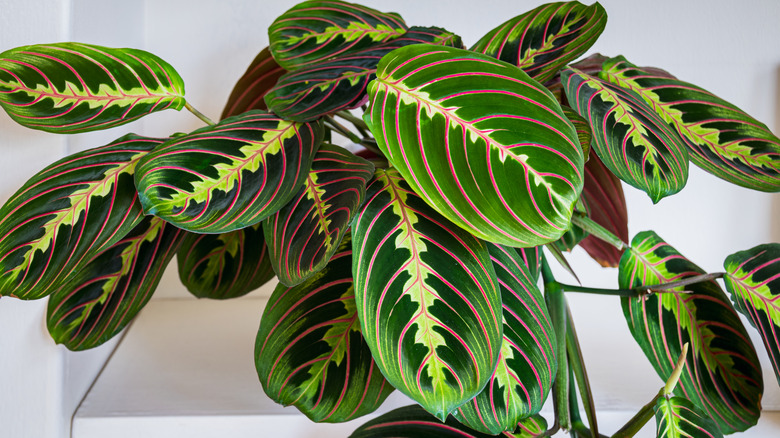The Easy-To-Grow Plant You'll Want To Keep Out Of Your Home
Many plant lovers rejoice when they find a houseplant that's easy to grow and hard to kill. The dieffenbachia — which is also hard to pronounce — is one such plant. By the way, it's pronounced dee-eh-fun-BAA-kee-uh, so you may prefer calling it by its more common name, the dumb cane plant. These plants grow well indoors in indirect sunlight and are a popular choice for many houseplant enthusiasts, thanks to their large green and white leaves. Unfortunately, though, this plant is toxic to dogs and cats, as well as children, if ingested. So, if you want to keep your animals and kids safe, bringing a dumb cane plant into your home may not be the best idea.
Dumb cane toxicity symptoms in pets include vomiting, extreme mouth irritation, difficulty swallowing, and uncontrollable drooling in both humans and dogs and cats. Although poisoning isn't fatal, it can still land your pet or child in the emergency room. To eliminate any hazards to your four-legged friends, you might be able to grow the plant outdoors, depending on where you live. You can also purchase a safe, nontoxic houseplant alternative that resembles the dumb cane plant to brighten up your indoor space.
You might be able to grow dieffenbachia outdoors
People are drawn to certain plants for different reasons, like the overall appearance, the size, or the ease of care. Perhaps you fell in love with the dumb cane plant the first time you saw it, or maybe you just love how easy it is to grow and maintain. If that's the case, you'll be happy to know that this plant can thrive outdoors year-round, but only if you live in zones 10 and up. These zones include south Florida, most of Hawaii, the southernmost portion of Texas, southeast California, the Florida Keys, and all of Puerto Rico.
Ready to successfully grow a dieffenbachia plant? It can be the perfect addition to create a front lawn garden or in pots in a partially shaded area without direct sunlight. It can pair well with plants with complementary-colored leaves, such as those in the red family like the Chinese evergreen. Make sure there's sufficient drainage and moisture in the soil for these dumb cane plants at all times. With the right conditions, dumb canes can grow 3 to 6 feet tall, so consider this before you decide where to plant it.
Two safe indoor alternatives to the dieffenbachia plant
The dumb cane plant may not be the best indoor plant if you share your home with a dog or cat, but the good news is that other easy-to-grow, safer options look similar to this plant. The aluminum plant, also known as the watermelon plant, can be a great indoor plant and does not pose a toxicity risk if ingested. It features green and silver leaves that look similar to the dumb cane plant, only smaller and with a different pattern. Like the dumb cane, the aluminum plant thrives in bright, indirect sunlight. One area where these two plants differ, though, is in height. The aluminum plant doesn't grow as large as the dumb cane. Indoors, the latter can grow up to 3 feet tall, but the aluminum plant tops out at only about a foot tall.
Another safe alternative is the red-veined prayer plant, a vining plant with dark green and yellow leaves and pinkish-red veins — hence the name. The leaves can grow to about 4 to 8 inches long, compared to the dumb cane's 18-inch long leaves. To get the most from your prayer plant, it needs bright, indirect sunlight to survive. It can grow 12 to 15 inches tall indoors. With these alternatives, added to the many other nontoxic species, you can have beautiful, lush plants indoors while keeping your vulnerable family members safe.


